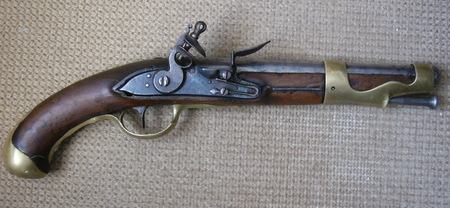French 1763/66 Cavalry Pistol
Sold
DESCRIPTION
French 1763/66 Cavalry Pistol. Probably the most common type of handgun supplied to the American rebels by France, according to Neumann, who illustrates is as number 22.PP on page 253 of Battle Weapons of the American Revolution. Brass mounted with side plate, triggerguard, nose band and butt cap all showing an inspectors mark consisting of an N surmounted by lobed crown (or perhaps a lobed cross, clover or fleur-de-lis), the same marking appearing on the interior of the lock next to the makers initials LM." Barrel marked on left breech DY76 over a J. The left stock flat bears an stamped cartouche reading JU[?] over DY over 76. The number on the flat and the barrel indicating manufacture or assembly in 1776. The JU indicates the month of June or July. The J on the barrel may be a month code as well. The DY appears stamped in the wood again on the top of the wrist.
The pommel shows three short repaired cracks near the pommel cap. The metal has been cleaned, but is now toning down again slightly. The barrel did not lose any detail in the cleaning. The muzzle shows a little roughness, but measures 9 inches, the length to which these barrels were reduced in 1766. The barrel markings are very clear at the left breech. There is no sign of a model year stamped on the breechplug tang and the does not seem to have been any. The lockplate was cleaned of corrosion and then colored, giving it a slightly bluish/pewter cast- most likely wiped with a cold blue. The hammer, frizzen and frizzen-spring show more brown. The gun appears to be in original flint. The touch hole is in good shape, not burnt out, but also showing no sign of bushing or corrosion around it (which can be a sign of reconversion.) Lock is the 1766 flat hammer style. The lockplate shows a very clear Manufacture engraved over a partially visible Charleville, with the first half of the name obscured by a patch of pitting. The external lock inspectors mark is present, but only faintly visible, showing what I think is part of the same lobed cross appearing over an "N" on other parts. The rod is a modern replacement. The hammer top jaw is frozen in place, but the lock is functional. The interior of the lock shows a repair to the sear where the horizontal arm must have cracked and was brazed. There is a small piece of wood out below the lock, the usual result of someone removing the lock without placing it on half-cock.
Overall a decent example of a Rev War pistol at a reasonable price.
The pommel shows three short repaired cracks near the pommel cap. The metal has been cleaned, but is now toning down again slightly. The barrel did not lose any detail in the cleaning. The muzzle shows a little roughness, but measures 9 inches, the length to which these barrels were reduced in 1766. The barrel markings are very clear at the left breech. There is no sign of a model year stamped on the breechplug tang and the does not seem to have been any. The lockplate was cleaned of corrosion and then colored, giving it a slightly bluish/pewter cast- most likely wiped with a cold blue. The hammer, frizzen and frizzen-spring show more brown. The gun appears to be in original flint. The touch hole is in good shape, not burnt out, but also showing no sign of bushing or corrosion around it (which can be a sign of reconversion.) Lock is the 1766 flat hammer style. The lockplate shows a very clear Manufacture engraved over a partially visible Charleville, with the first half of the name obscured by a patch of pitting. The external lock inspectors mark is present, but only faintly visible, showing what I think is part of the same lobed cross appearing over an "N" on other parts. The rod is a modern replacement. The hammer top jaw is frozen in place, but the lock is functional. The interior of the lock shows a repair to the sear where the horizontal arm must have cracked and was brazed. There is a small piece of wood out below the lock, the usual result of someone removing the lock without placing it on half-cock.
Overall a decent example of a Rev War pistol at a reasonable price.











